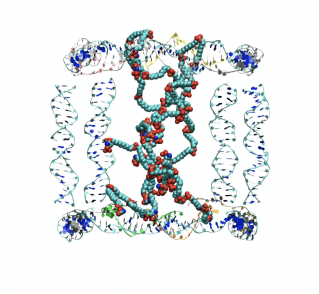Dec 20 2017
Polymer particles have been chemically imprinted with DNA strands by McGill University researchers – a technique capable of leading to new materials for applications ranging from biomedicine to “soft robotics” (a promising field).
 Credit: McGill University
Credit: McGill University
In a study published in Nature Chemistry, the researchers talk about a method for developing asymmetrical polymer particles that have the potential to bind together in a spatially defined manner, the way in which atoms come together in order to make molecules.
Even though polymers are used in everything from food packaging to clothing to 3D printing and electronics, most self-assembled polymer structures have been restricted to symmetrical forms such as cylindrical or spherical shapes. However, recently, scientists have focused on developing non-symmetrical polymer structures - for instance ‘Janus’ particles with two varied ‘faces’ - and they are beginning to discover exciting new applications for these materials. One example refers to robotics developed with flexible, soft structures that can change shape in response to external stimuli.
The method explained in the Nature Chemistry paper “introduces a programmable level of organization that is currently difficult to attain in polymer chemistry,” says McGill Chemistry professor Hanadi Sleiman, senior author of the study.
Chemically copying the information contained in DNA nanostructures offers a powerful solution to the problem of size, shape and directional control for polymeric materials.
Hanadi Sleiman, Senior Author of the Study and Chemistry Professor, McGill
Using DNA cages as molds
The new study builds on a technique that has been developed in 2013 by Sleiman’s research group in order to make nanoscale “cages” from strands of DNA, and then stuff them with lipid-like polymer chains that fold together into a ball-shaped particle capable of containing cargo such as drug molecules.
Sleiman and her PhD student Tuan Trinh collaborated with colleagues at the University of Vermont and Texas A&M University at Qatar in order to take the nano-engineering feat a step further. Together, the researchers came up with a method for imprinting the polymer ball with DNA strands placed in pre-designed orientations.
It is then possible to undo the cages, leaving behind DNA-imprinted polymer particles that can self-assemble – much like DNA, itself – in pre-designed patterns. The DNA cages are used as a ‘mold’ for building the polymer particle, and because of this it is possible to precisely control the particle size and number of molecular units in the polymer, says Sleiman, who holds the Canada Research Chair in DNA Nanoscience.
The researchers further say that the asymmetrical polymer structures could be eventually used in a variety of applications. One promising example refers to multi-compartment polymer particles, with every single compartment encapsulating a drug capable of being delivered by using varied stimuli at different times. Another possibility refers to porous membranes that are asymmetric, and hence they direct molecules along particular paths in order to separate then.
The research was funded by the Natural Sciences and Engineering Research Council of Canada, the Canadian Institutes for Health Research, the Centre for Self-Assembled Chemical Structures, the Qatar Research Foundation and the Canada Research Chairs Program.
DNA Cage
Researchers at McGill University, the University of Vermont and Texas A&M University in Qatar have developed a method to chemically imprint polymer particles with DNA strands. This approach could lead to new materials for applications ranging from biomedicine to “soft robotics.” This computer simulation shows the first step of this process, in which the polymer chains associate together and fold inside the DNA cage. (CREDIT: The Li Research Group/University of Vermont)